#mascarene
Explore tagged Tumblr posts
Text

Indo-Pacific bottlenose dolphin Tursiops aduncus
Observed by coralwaters, CC BY-NC
#Tursiops aduncus#Indo-Pacific bottlenose dolphin#Cetacea#Delphinidae#cetacean#dolphin#Africa#Mascarenes#Mauritius#Indian Ocean#underwater
46 notes
·
View notes
Text

March 7, 2024 - Mascarene Paradise-Flycatcher (Terpsiphone bourbonnensis) Found on the islands of Reunion and Mauritius, these monarch flycatchers live in and around forests, plantations, and gardens. Usually foraging alone, they eat insects, capturing them in short flights, sometimes while hovering, or picking them from leaves in flight or while perched. They build cone-shaped nests from green moss, lichen or spider egg cases, and spiderweb in small trees where females lay clutches of two or three eggs. Both parents incubate the eggs and feed the chicks.
#mascarene paradise-flycatcher#monarch flycatcher#terpsiphone bourbonnensis#bird#birds#illustration#art#tropical#birblr art
44 notes
·
View notes
Text
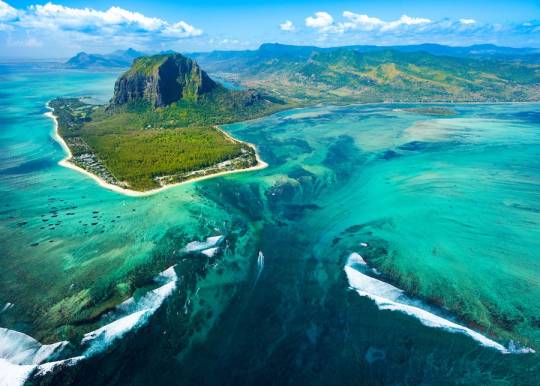
Mind-boggling optical illusions you can find in nature
There's a simple geographical explanation for this phenomenon.
Along the shoreline of Mauritius, there appears to be a flowing river underneath the turquoise water of the Indian Ocean. While underwater waterfalls do exist, according to the National Ocean Service, this isn't one of them. In this case, what looks like water is actually sand getting pushed off an underwater shelf called the Mascarene Plateau, according to Britannica.
Myroslava Bozhko/Shutterstock
#myroslava bozhko#photographer#shutterstock#optical illusion#mauritius#indian ocean#underwater waterfalls#mascarene plateau
5 notes
·
View notes
Text
but also infuriated at the whole situation because i missed out on two rare vagrant birds that rocked up nearby that would have been major ticks because i simply couldn't get there
3 notes
·
View notes
Text

For Day 2 of Bat week this is the Greater Mascarene or the Mauritian Flying Fox (relative of the extinct small Mauritian flying Fox)
This species is endangered and has occasional culls because of fruit farmers’ protection. It’s the island’s most important pollinator and seed disperser. So uh stop doing that.
It doesn’t threaten fruit farms any more than invasive species which don’t disperse seeds as well :-)
5 notes
·
View notes
Text

#reunion#reunion island#saint denis#mascarene islands#indian ocean#places#2002#older sibling core#quicksilver
1 note
·
View note
Photo

A new variant has been added!
Mascarene Swiftlet (Aerodramus francicus) © Kévin Le Pape
It hatches from brown, easy, erratic, high, overall, small, and swift eggs.
squawkoverflow - the ultimate bird collecting game 🥚 hatch ❤️ collect 🤝 connect
1 note
·
View note
Text











Подводные бабочки-рыба, которой даны крылья, но не для полета- Восточная дактилоптена.
Восточная дактилоптена, или восточная летучка (лат. Dactyloptena orientalis), — вид лучепёрых рыб семейства долгопёровых (Dactylopteridae). Широко распространены в Индо-Тихоокеанской области от юга Африки до Красного моря и Персидского залива, включая Мадагаскар и Маскаренские острова. На север до Японии и островов Бонин; на восток до Тонга, Рапа-Ити, Гавайских островов и островов Питкэрн и на юг до Западной Австралии, Нового Южного Уэльса и Новой Каледонии. Максимальная длина тела 40 см, обычно до 20 см
Тело у этих необычнх рыб массивное, удлинённое, почти квадратное в поперечном сечении. Покрыто костной чешуёй, которая образует продольные гребни. Голова большая и заключена в костный панцирь. Глаза у дактилоптены большие. Рот маленький, полунижний с крошечными зубами на обеих челюстях, сошнике и нёбных костях. В углу предкрышки расположен длинный шип; его окончание не заходит за окончание первой спинной колючки. У восточной летучки два спинных плавника; в первом спинном плавнике 5 колючих лучей; второй спинной плавник с 8 мягкими лучами отделён от первого спинного плавника глубокой выемкой. Хвостовой плавник с небольшой выемкой, удлинённый у взрослых особей. Грудные плавники с горизонтальным основанием, разделены на две части: передней, образованной пятью короткими лучами, и задней с 27—30 длинными лучами, окончания которых доходят до основания хвостового плавника; каждый луч с короткими нитями, выходящими за внешний край луча.
Окраска тела обычно желтовато-коричневая сверху и светло-коричневая снизу. По верхней части головы и тела разбросаны небольшие оранжевые точки; у особей крупнее 10 см обычно на верхней части головы есть большое тёмное пятно. На грудных плавниках беспорядочно разбросаны золотистые точки, более крупные в задней части. У мелких особей (длиной 50—65 мм) одно глазчатое тёмное пятно на нижней трети плавников. По хвостовому плавнику проходят четыре золотистые полосы. Золотистые полосы идут вдоль верхней части колючего спинного плавника.
Восточная дактилоптена это морская придонная рыба. Обитает на континентальном шельфе над песчаными грунтами на глубине от 1 до 100 м. Способна «ходить» по дну, используя для передвижения брюшные плавники и короткие лучи грудных плавников. Длинные лучи грудных плавников в спокойном состоянии прижаты к телу, а в случае опасности распрямляются для отпугивания хищников. Ведут одиночный малоподвижный образ жизни. Питаются ракообразными, моллюсками и мелкими рыбами.
Underwater butterfly fish that have wings, but not for flight - Eastern Dactyloptena.
The Oriental flying gurnard, or Purple Flying Gurnard, (lat. Dactyloptena orientalis), is a species of ray-finned fish of the long-finned fish family (Dactylopteridae). Widely distributed in the Indo-Pacific region from southern Africa to the Red Sea and the Persian Gulf, including Madagascar and the Mascarene Islands. To the north to Japan and the Bonin Islands; to the east to Tonga, Rapa Iti, Hawaii and the Pitcairn Islands and to the south to Western Australia, New South Wales and New Caledonia. The maximum body length is 40 cm, usually up to 20 cm.
The body of these unusual fish is massive, elongated, almost square in cross-section. Covered with bony scales, which form longitudinal ridges. The head is large and enclosed in a bony shell. The eyes of Dactyloptenae are large. The mouth is small, semi-inferior with tiny teeth on both jaws, the vomer and the palatine bones. In the corner of the preoperculum there is a long spine; its end does not extend beyond the end of the first dorsal spine. The eastern bat has two dorsal fins; the first dorsal fin has 5 spiny rays; the second dorsal fin with 8 soft rays is separated from the first dorsal fin by a deep notch. The caudal fin with a small notch, elongated in adults. The pectoral fins with a horizontal base, are divided into two parts: the anterior, formed by five short rays, and the posterior with 27-30 long rays, the ends of which reach the base of the caudal fin; each ray with short filaments extending beyond the outer edge of the ray. The body color is usually yellowish-brown on top and light brown below. Small orange dots are scattered over the top of the head and body; individuals larger than 10 cm usually have a large dark spot on the top of the head. Golden dots are randomly scattered on the pectoral fins, larger at the back. Small individuals (50-65 mm long) have one eye-shaped dark spot on the lower third of the fins. Four golden stripes run along the caudal fin. Golden stripes run along the upper part of the spiny dorsal fin.
The Purple Flying Gurnard, is a marine bottom fish. It lives on the continental shelf over sandy bottoms at depths from 1 to 100 m. It is able to "walk" along the bottom, using its pelvic fins and short rays of the pectoral fins for movement. The long rays of the pectoral fins are pressed to the body when calm, and in case of danger they straighten out to scare off predators.They lead a solitary, sedentary lifestyle. They feed on crustaceans, mollusks and small fish.
Источник:://ru.wikipedia.org/wiki/Восточная_дактилоптена, ://www. clasbio.ru/classification.php?id=13255, //fishesofaustralia.net.au/ home/species/4640.
#fauna#video#animal video#marine life#marine biology#nature#aquatic animals#Dactyloptena orientalis#Purple Flying Gurnard#Oriental flying gurnard#sea creatures#ocean#sea#fish#sand#beautiful#animal photography#nature aesthetic#видео#фауна#природнаякрасота#природа#океан#море#рыбы#Восточная дактилоптена#песок
300 notes
·
View notes
Text
THREE NEW SHARK SPECIES THIS WEEK!
The second week of July 2023 something extraordinarily beautiful happened, the findings of 3 new species of sharks for were announced
A new angel sharks species was identified, from the western Indian Ocean on the Mascarene Plateau and off southwestern India in 100–500 m depths, the Lea’s angel shark Squatina leae, was recognized to be different genetically and morphologically distinct from its congeneric species Squatina africanae, following unique morphological features. This species was first detected in 1988 after finding three unusual, small sharks, but till today was completely understood. The angel shark is named after one of the author’s fiancee’s late sister, Lea-Marie Cordt.
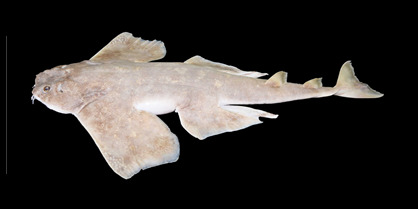
- Squatina leae, adult male, in dorsolateral.
Angel sharks are “flatter sharks”, possesing distinctly broad, dorsoventrally flattened bodies, a short snout with large mouth and nostrils, eyes on top of the head close to the large spiracles, very large pectoral fins, and a lateral caudal keel. They've evolved to be ambush predators, they lie in wait for prey to pass closely overhead before attacking.
Reference (Open Access): Weigmann et al., 2023. Revision of the Western Indian Ocean Angel Sharks, Genus Squatina (Squatiniformes, Squatinidae), with Description of a New Species and Redescription of the African Angel Shark Squatina africana Regan, 1908. Biology
From North Australia, another species of hornshark is described based on six whole specimens and a single egg case. The painted hornshark Heterodontus marshallae was previously considered to be the same with the zebra bullhead shark another well know bullhead shark from the central Indo-Pacific from Japan to Australia, but genetic and morphological analyses indicated the sharks were different, but looking alike. The painted hornshark is endemic to northwestern Australia and occurs in deeper waters, at 125–229 m below surface.
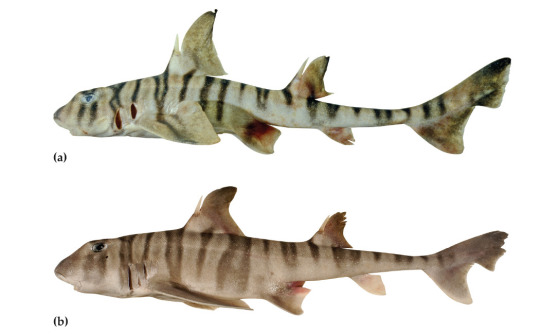
- Lateral view of two mature female painted hornshark Heterodontus marshallae showing small differences between individuals
The painted hornsharks is named in honour of Dr. Lindsay Marshall www.stickfigurefish.com.au a scientific illustrator and elasmobranch scientist who expertly painted all the sharks and rays of the world for the Chondrichthyan Tree of Life Project.
Reference (Open Access): White et al., 2023 Species in Disguise: A New Species of Hornshark from Northern Australia (Heterodontiformes: Heterodontidae). Diversity.
And from an unidentified shark egg collected from the deep waters of northwestern Australia, in 2011 recently helped researchers identify a new species of deep water cat shark. Called ridged-egg catshark Apristurus ovicorrugatus after its eggs, it was collected in the earlys 90 but remained unknown to date. This sharks presents white eyes, and is small in size, reaching less than a half meter in length. .
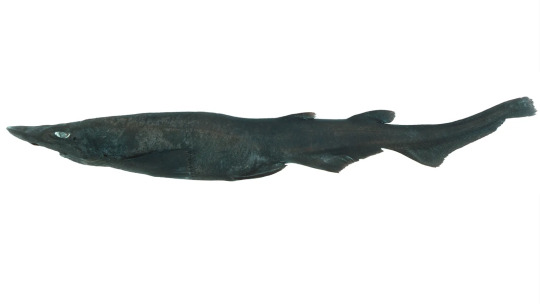
- Lateral view of female Apristurus ovicorrugatus before preserved. Photo by CSIRO.
Egg cases belonging to this species had been documented as early as the 1980s, but could not be matched to any species of Australian shark until recently scientists examined a shark specimen of previously uncertain identity in the CSIRO collection.
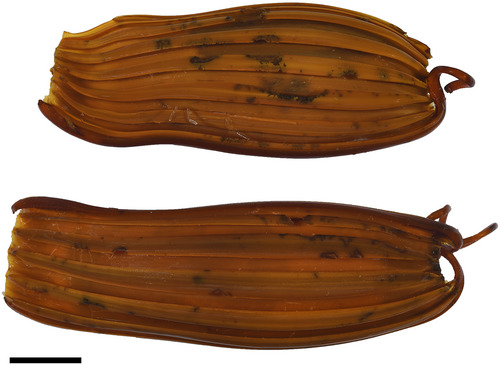
-egg cases of Apristurus ovicorrugatus. Scale bar is 10 mm
Reference (Open Access) White,et al., 2023 What came first, the shark or the egg? Discovery of a new species of deepwater shark by investigation of egg case morphology. Journal of Fish Biology.
#Squatina leae#Squatina#new species#elasmobranch#shark#biology#marine biology#science#marine science#indian ocean#bioblr#sciblr#sci#painted hornshark#Heterodontus marshallae#Heterodontus#Apristurus ovicorrugatus#Apristurus#long post#Ridged-egg catshark#Lea’s angel shark
3K notes
·
View notes
Text

Mascarene Islands, Gemini VI-A.
24 notes
·
View notes
Text
Kadalia



Kadalia is a medium-sized continent, located within the Southern and Eastern Hemispheres, surrounded by the Kadalian Ocean from the north, west and east and by the Sagastanian Ocean from the south. The Voay Sea (also called the Voay Channel) lies between Kadalia and Africa, while the Sea of Sejuk separates Kadalia from Sagastan. The archipelago of Tanana, as well as multiple islands, such as Panya, lay on Kadalian continental shelf and are considered part of the continent, especially since many of them (though not the Tanana Archipelago) were connected to the mainland during the glacial maximums.
Kadalia is composed of different parts of ancient continent of Gondwana, those that in OTL would form Madagascar, Kerguelen, Seychelles and Mascarene Islands. On Tehar, they are conjoined in the form of a large landmass above sea level.
Kadalia has a variety of climates, from frigid tundras of Sejuk to hot rainforests of Tanana. It has relatively few mountains and is mostly flat. Kadalia is home to an extraordinarily unique biota, since it existed separate from the other landmasses for at least 66 million years. It's human history is long, and nowadays it is home of a variety of ethnic groups. Historically it was often considered "the crossroads between Libya and Tanah", and humans first came to it's shores from both sides.
Compared to the mountainous landmasses, such as Skiffia or Hatunwata, Kadalia is relatively flat. It's highest mountain is Mount Hitam, part of the Besar Mountains, in the southeast. It reaches just 3568 meters above sea level. The lowest point of Kadalia, the marshy lowlands of Lubang Rawa, is -13 meters below sea level. Most of the continent is either flat or hilly, with only a few minor ridges. The lowlands are home to multiple large rivers, flowing from the mountain peaks towards seas or lakes.
Volcanism is relatively prevalent in the southernmost parts, such as Besar, as well as in the Alas and Ramona Ridges. Active volcanoes exist, with multiple eruptions in the last few hundred years.
Glaciation exists in a significant portion of the mountains of Kadalia. While no part of the continent is covered by ice shields, unlike, for example, the frozen Sagastan, the glaciers in the southeast frequently reach low latitudes. Ocean waters south of Kadalia are often full of icebergs.
The most famous lake on Kadalia, the Ularair Lake, is of glacial origins. It has been carved up during the LGM.
Kadalia has been isolated since Late Cretaceous, when it completely broke away from Arda, right before the end-Cretaceous mass extinction event. Prior to that, it was a part of the ancient continent Gondwana, which causes a large portion of it's biota to share common origins with those from other Southern Hemisphere landmasses.
The minerals of Kadalia include copper, iron, manganese, gold, sapphires and others. Fossil fuels found include moderate amounts of oil, gas and relatively larger reserves of coal.
#tehar#alternate history#worldbuilding#speculative evolution#speculative biology#continent#cartography#topography
4 notes
·
View notes
Text

Mascarene Parrot by Nick Bibby
The Mascarene parrot is an extinct parrot from the Mascarene island.
2 notes
·
View notes
Text
Speculative evolution and alternate history bros are sleeping on the endless possibilities that come by saying "hey what if this seamount/oceanic plateau was an island?"
Sure, everybody and their mother's seen or done spec work on a surviving Doggerland or Zealandia, but we're all missing out on the Mascarene Plateau or the New England seamounts or the Rockall Plateau or literally ANYTHING else that lies just beneath the waves. Think of the unique cultures and wildlife that would form on these islands, think of how much they could impact broader world history
I mean GUYS

#speculative evolution#speculative biology#alternate history#geography#nature#history#ecology#culture#when I say the possibilities are endless man I MEAN that#yes this was inspired by Atlas Pro's video on lost islands#and his interview with Cody
5 notes
·
View notes
Text




LIONEL SABATTÉ - PETITS OISEAUX DES ÎLES, 1989-2014
Series of 20 drawings, oxydation on Arches paper
"I grew up in Reunion. In 2014 I returned to the Indian Ocean archipelago of the Mascarenes, it had been 20 years since I had returned to the region. I found the birds, these little birds from the islands that I had forgotten and that make up a whole diversity of shapes, songs and behaviors. They took me instantly back to the 90s, to my teenage days… I decided to draw a set of 20 imaginary birds to translate this emotion. Drawings by oxidations of metallic solutions on paper where the deterioration of the material becomes a verdigris and rust plumage. These birds are also for me like land, islands seen from the sky, both birds and the flight of birds. They are small escape spaces where what damages and destroys, rust, is transformed into a construction element. I hope they will act as such in Kyiv and that they will share something of the wonder of the islands where they were drawn like little flights to lands to come…"
Lionel Sabatté
Small wonders of the islands spotted at Module of Temporality, Kyiv, 2023
3 notes
·
View notes
Photo
By being a badass. Pink pigeons are the only mascarene pigeon to have not gone extinct. Critically endangered.
Or maybe it just ate a lot if shrimp like a flamingo


there is a pink pigeon wandering around nyc I wonder how she got here
120K notes
·
View notes
Text
Giacimenti d'oro nei vulcani delle isole francesi

Una nuova super-miniera di oro sta per arrivare in Europa. Scoperto un nuovo modo di capire dove e come si forma l’oro. Questa nazione potrebbe ricavarne tonnellate. Una recente scoperta potrebbe rivoluzionare il campo della geologia, ridefinendo la comprensione del processo di formazione e risalita dell’oro verso la superficie terrestre. Un team di ricercatori internazionali ha sviluppato un modello innovativo che spiega come il metallo prezioso venga trasportato dal mantello terrestre fino alle rocce vulcaniche in superficie. Per la prima volta, uno studio fornisce un metodo affidabile per individuare nuovi giacimenti con maggiore precisione, riducendo i costi e i rischi legati alle tradizionali operazioni di ricerca. Attraverso simulazioni in laboratorio, gli scienziati hanno replicato le condizioni estreme in cui si forma il magma, scoprendo il ruolo cruciale delle zone di subduzione. Qui, il movimento delle placche terrestri facilita la risalita del magma, arricchito da fluidi solforati essenziali per la formazione di depositi auriferi. Questo processo è particolarmente attivo nell’oceano Pacifico, caratterizzato da un’intensa attività vulcanica. Per la Francia arriva una nuova età dell’oro La recente scoperta sui processi che consentono all’oro di risalire in superficie attraverso le zone vulcaniche apre nuove prospettive per la geologia e per le nazioni che stanno investendo nella ricerca di nuovi giacimenti. Tra queste spicca la Francia, che, insieme a Cina, Svizzera e Australia, è tra i paesi più attivi nella ricerca dell’oro. Proprio la Francia potrebbe trarre i maggiori benefici da questa scoperta, grazie alla presenza di territori vulcanici come le isole Martinica e Riunione, che potrebbero nascondere enormi giacimenti auriferi dal valore stimato in miliardi di euro. Lo sfruttamento di queste risorse non solo trasformerebbe l’economia locale, ma potrebbe posizionare la Francia come un nuovo leader nel settore dell’oro.

Tuttavia, ulteriori ricerche sono necessarie per sfruttare appieno il potenziale di questa scoperta. Comprendere meglio questi processi potrebbe rivoluzionare l’industria mineraria, permettendo l’accesso a giacimenti prima inaccessibili e riducendo la dipendenza da tecniche costose e invasive. Inoltre, questa svolta scientifica potrebbe favorire lo sviluppo di nuove tecnologie estrattive più sostenibili, con minori costi economici e un impatto ambientale ridotto. L’abilità di prevedere con precisione la posizione dei giacimenti d’oro potrebbe cambiare radicalmente il panorama economico globale. Da un lato, l’individuazione di nuovi depositi potrebbe modificare le sorti economiche di intere nazioni; dall’altro, l’estrazione mirata renderebbe superflue molte delle attuali operazioni esplorative basate su trivellazioni e miniere spesso infruttuose. Questa scoperta rappresenta una svolta epocale, proiettando la geologia verso una nuova era, in cui la ricerca dell’oro diventa più efficiente, sostenibile e strategicamente rilevante per l’economia globale. Dove si trovano le isole Martinica e Riunione Le isole Martinica e Riunione si trovano in due diverse zone dell’oceano, ma entrambe sono territori d’oltremare della Francia. Martinica è situata nel Mar dei Caraibi, a nord di Saint Lucia e a sud di Dominica, ed è parte dell’arcipelago delle Antille. Fa parte delle Piccole Antille. Riunione si trova nell’Oceano Indiano, a est del continente africano, a sud-ovest dell’isola di Mauritius e a circa 700 km a est del Madagascar. È un’isola vulcanica nell’arcipelago delle Mascarene. Entrambe sono isole francesi, ma si trovano in aree geografiche molto distanti tra loro. Entrambe possono fare la fortuna della nazione francese grazie al loro territorio vulcanico che potrebbe portare alla scoperta di importanti giacimenti di oro ancora sconosciuti. Read the full article
0 notes